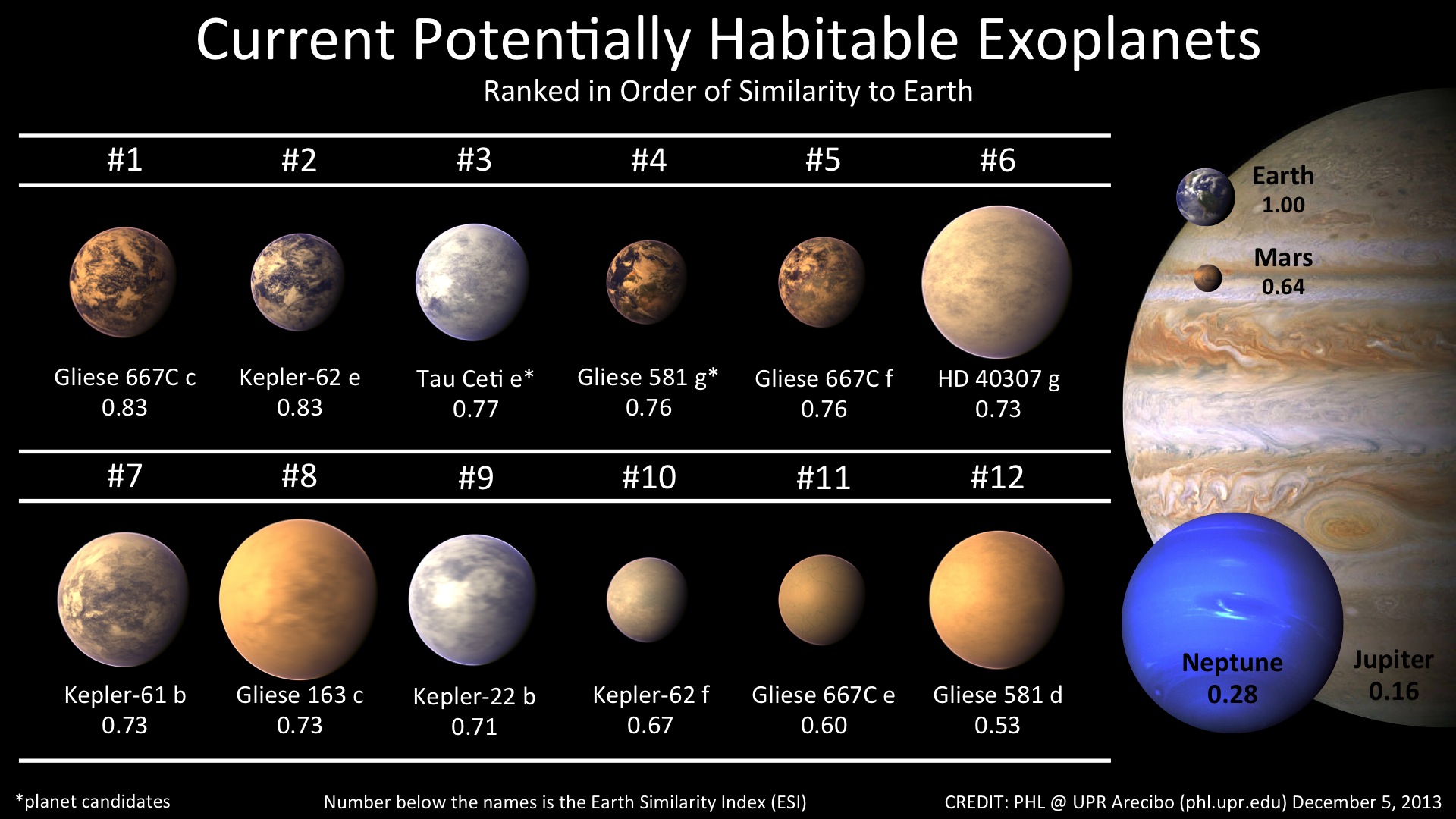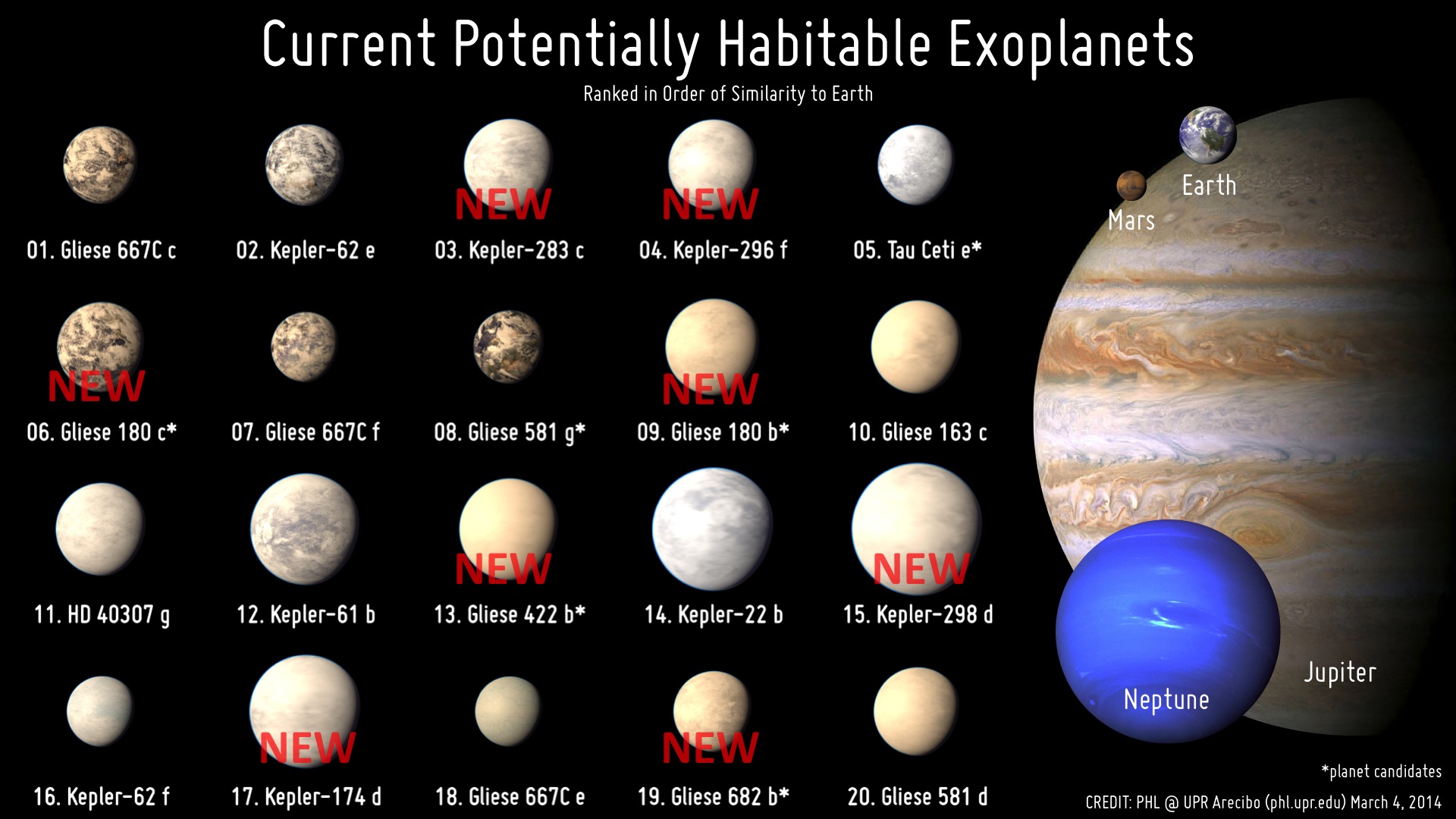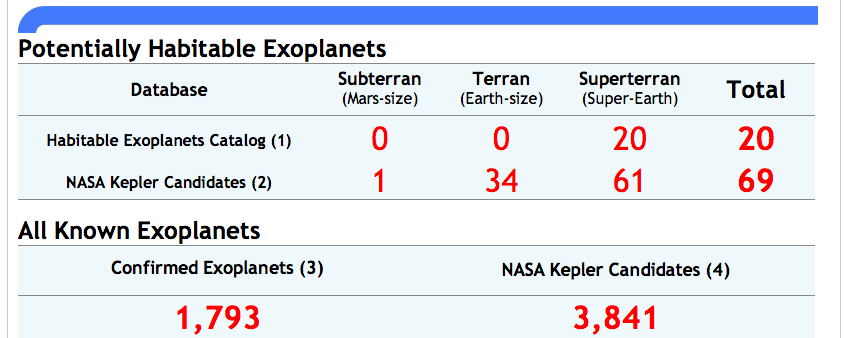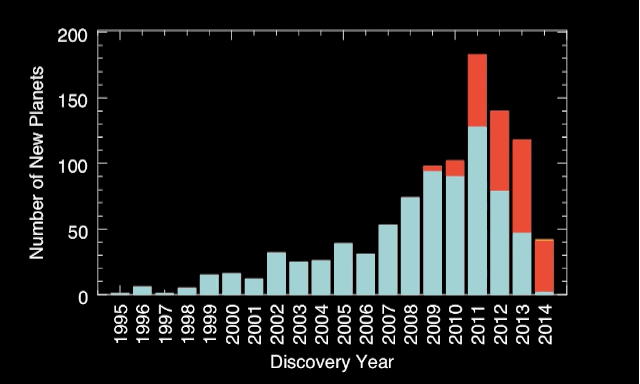It looks like you're using an Ad Blocker.
Please white-list or disable AboveTopSecret.com in your ad-blocking tool.
Thank you.
Some features of ATS will be disabled while you continue to use an ad-blocker.
share:
I like reading what you're all posting but I want to make sure I have this right.
It can sustain life if it is between .97-1.37 AU from its sun. It would need to be close to our mass and density and have a close to circular orbit. Otherwise temperatures would be too extreme to inhabit. For gravity you would look at mass/volume.
This is what would hold the atmosphere in place so gravity is critical. That's about it then...for the most part?
It can sustain life if it is between .97-1.37 AU from its sun. It would need to be close to our mass and density and have a close to circular orbit. Otherwise temperatures would be too extreme to inhabit. For gravity you would look at mass/volume.
This is what would hold the atmosphere in place so gravity is critical. That's about it then...for the most part?
these are all rules of thumb. there are many variables. and in some cases its just a wild guess. for example, exo moons around gas giants may have
tidal factors that heat up a planet sized moon beyond what we would think would be the habitable zone of the parent star. the life zones of red dwarfs
is within the distance of mercury to thier parent star. and brown dwarfs which are really cold compared to stars but radiate heat that is often quite
comfortable by human standards; you would have to be even closer. and for some of the colder Y class brown dwarfs if you could stand on one you would
be in shirt sleeve environments.
also the life zone of stars is constantly being revised. right now they have moved the life zone estimate out again and in this new understanding earth is just barely within the inner edge of our own sun's lifezone rather than being right in the middle of it. and if you consider extremophiles the lifezone goes out to saturn and probably beyond.
also the life zone of stars is constantly being revised. right now they have moved the life zone estimate out again and in this new understanding earth is just barely within the inner edge of our own sun's lifezone rather than being right in the middle of it. and if you consider extremophiles the lifezone goes out to saturn and probably beyond.
This all sounds like propaganda to me.
to get people exited about colonizing planets.
Like what they did for the Moon landings.
But I dont see how we get their soon?
or will they suddenly discover a magnetic space drive?
that can get us to other planets easily.
we do have far to many people on earth.
and a lot of them like traveling to new countries.
so send the immigrants to space!
is this why they let the population grow so big?
but why do they wont them on other worlds?
to feed the aliens!
to get people exited about colonizing planets.
Like what they did for the Moon landings.
But I dont see how we get their soon?
or will they suddenly discover a magnetic space drive?
that can get us to other planets easily.
we do have far to many people on earth.
and a lot of them like traveling to new countries.
so send the immigrants to space!
is this why they let the population grow so big?
but why do they wont them on other worlds?
to feed the aliens!
Here are a couple of recently updated graphics from the Planetary Habitability Lab at Arecibo, PR to show what a dramatic increase in planets,
specifically, potentially habitable planets and planet candidates the new windfall of both confirmed planets and candidates revealed last week
provided.
We have gone from only 1 potentially habitable Earth analog candidate to 34!
All it will take is for one of them to be verified and we will have found our potential "Earth 2.0".
Before February 26, 2014


Today


And this graph from NASA shows the dramatic increase in planets in general:

We have gone from only 1 potentially habitable Earth analog candidate to 34!
All it will take is for one of them to be verified and we will have found our potential "Earth 2.0".
Before February 26, 2014


Today


And this graph from NASA shows the dramatic increase in planets in general:

oh, i hope soon they find one close enough for all the global leaders to be blasted off to.
remember a smallish super earth isn't necessarily a "no go" for gravity. it could be less metal rich than earth or otherwise have less dense materials
which would result in lighter gravity than it's size would imply. since several of the super earths
are "only slightly super" super earths this might be a possibility. though super earths have other drawbacks besides gravity. like potential or even probable crushing atmospheres, possibly no tectonics even if not tidally locked, and without tectonics oceans and surface water may not exist.
but the good news is all the super jupiters. these mean super moons and lots of them. and the bigger ones may even radiate thier own heat. even if they don't they will reflect the parent star's light and heat onto thier moons. plus by tidal stress they may keep a moons core molten. and if we don't confine ourselves to terrestrial environments there might be floating gas bag life forms or airborne plants or microbes. or aquatic life or something more exotic.
are "only slightly super" super earths this might be a possibility. though super earths have other drawbacks besides gravity. like potential or even probable crushing atmospheres, possibly no tectonics even if not tidally locked, and without tectonics oceans and surface water may not exist.
but the good news is all the super jupiters. these mean super moons and lots of them. and the bigger ones may even radiate thier own heat. even if they don't they will reflect the parent star's light and heat onto thier moons. plus by tidal stress they may keep a moons core molten. and if we don't confine ourselves to terrestrial environments there might be floating gas bag life forms or airborne plants or microbes. or aquatic life or something more exotic.
edit on 3-3-2014 by stormbringer1701 because: (no reason given)
"Virtually all red dwarfs have at least one earth like or super earth planet orbiting them." why is this important? Red dwarfs are the most abundant
type of star not only near earth but throughout the galaxy and perhaps the universe. before you get 6 light years from earth you have three of them. a
red dwarf is the nearest star from Sol. a red dwarf is also the 4rth and 5th nearest star to our sun.
www.sciencedaily.com...
and
www.sciencedaily.com...
The study identifies that virtually all red dwarfs, which make up at least three quarters of the stars in the Universe, have planets orbiting them.
The research also suggests that habitable-zone super-Earth planets (where liquid water could exist and making them possible candidates to support life) orbit around at least a quarter of the red dwarfs in the Sun's own neighbourhood.
and
These discoveries add eight new exoplanets signals to the previous total of 17 already known around such low-mass dwarfs. The paper also presents ten weaker signals for which further follow-up is necessary.
edit on 4-3-2014 by stormbringer1701 because: (no reason given)
edit on 4-3-2014 by stormbringer1701 because: moar stuff!
i mean these stars are the very nearest ones. we are on the cusp of three chances to get fusion propulsion going. even though the incrementalist
establishment are scoffing at even that. even though three groups are actually building prototype fusion engines. a couple of university and corporate
groups have even bent metal on thier designs, -one has even tested all the parts. still they are scoffed at. but fusion can get us to these stars in
a reasonable amount of time. with moderate relativistic speed any star within about 12 or 15 light years is in play even if we do not develop warp
drive or a traversible wormhole. that's a lot of stars. mostly red dwarfs, followed by k type and brown dwarfs followed by a couple of G type stars a
white dwarf and a supergiant.
here is a list of stars, brown dwarfs, white dwarfs, and planets within 20 light years of earth. note that there are up to 86 red dwarfs.
www.solstation.com...
here is a list of stars, brown dwarfs, white dwarfs, and planets within 20 light years of earth. note that there are up to 86 red dwarfs.
www.solstation.com...
edit on 4-3-2014 by stormbringer1701 because: (no reason given)
new topics
-
WF Killer Patents & Secret Science Vol. 1 | Free Energy & Anti-Gravity Cover-Ups
General Conspiracies: 1 hours ago -
Hurt my hip; should I go see a Doctor
General Chit Chat: 2 hours ago -
Israel attacking Iran again.
Middle East Issues: 3 hours ago -
Michigan school district cancels lesson on gender identity and pronouns after backlash
Education and Media: 3 hours ago -
When an Angel gets his or her wings
Religion, Faith, And Theology: 4 hours ago -
Comparing the theology of Paul and Hebrews
Religion, Faith, And Theology: 5 hours ago -
Pentagon acknowledges secret UFO project, the Kona Blue program | Vargas Reports
Aliens and UFOs: 6 hours ago -
Boston Dynamics say Farewell to Atlas
Science & Technology: 6 hours ago -
I hate dreaming
Rant: 7 hours ago -
Man sets himself on fire outside Donald Trump trial
Mainstream News: 9 hours ago
top topics
-
The Democrats Take Control the House - Look what happened while you were sleeping
US Political Madness: 9 hours ago, 18 flags -
In an Historic First, In N Out Burger Permanently Closes a Location
Mainstream News: 11 hours ago, 16 flags -
A man of the people
Medical Issues & Conspiracies: 17 hours ago, 11 flags -
Man sets himself on fire outside Donald Trump trial
Mainstream News: 9 hours ago, 9 flags -
Biden says little kids flip him the bird all the time.
Politicians & People: 9 hours ago, 9 flags -
Michigan school district cancels lesson on gender identity and pronouns after backlash
Education and Media: 3 hours ago, 6 flags -
Pentagon acknowledges secret UFO project, the Kona Blue program | Vargas Reports
Aliens and UFOs: 6 hours ago, 6 flags -
WF Killer Patents & Secret Science Vol. 1 | Free Energy & Anti-Gravity Cover-Ups
General Conspiracies: 1 hours ago, 6 flags -
Israel attacking Iran again.
Middle East Issues: 3 hours ago, 5 flags -
Boston Dynamics say Farewell to Atlas
Science & Technology: 6 hours ago, 4 flags
active topics
-
MULTIPLE SKYMASTER MESSAGES GOING OUT
World War Three • 53 • : Zaphod58 -
Israel attacking Iran again.
Middle East Issues • 26 • : NorthOS -
Michigan school district cancels lesson on gender identity and pronouns after backlash
Education and Media • 8 • : TheMichiganSwampBuck -
I Guess Cloud Seeding Works
Fragile Earth • 29 • : Justoneman -
Man sets himself on fire outside Donald Trump trial
Mainstream News • 40 • : Vermilion -
When an Angel gets his or her wings
Religion, Faith, And Theology • 5 • : randomuser2034 -
Anyone one else having Youtube problems
Computer Help • 11 • : charlyv -
The Democrats Take Control the House - Look what happened while you were sleeping
US Political Madness • 68 • : Mahogani -
Candidate TRUMP Now Has Crazy Judge JUAN MERCHAN After Him - The Stormy Daniels Hush-Money Case.
Political Conspiracies • 404 • : Zanti Misfit -
In an Historic First, In N Out Burger Permanently Closes a Location
Mainstream News • 10 • : Degradation33
